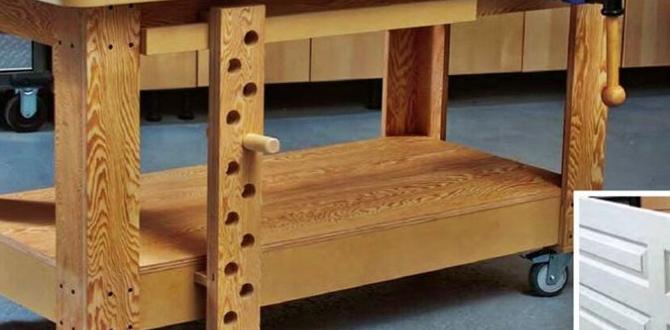Quick Summary:
Choosing the right nail for your material is key to a strong, lasting project. This guide helps you match nail type and size to wood, drywall, concrete, and more, ensuring project success and professional results every time.
Hey DIYers! Jack Shaffer here, your go-to guy for all things nail guns and woodworking. Ever stared at a box of nails, feeling totally lost? You’re not alone! Picking the perfect nail for different materials can seem tricky, but it’s a super important skill for making sure your projects hold together beautifully and safely. Don’t worry, I’m here to break it all down. We’ll go from understanding nail basics to picking the exact right fastener for your wood, drywall, or even tougher stuff. Let’s get you nailing it!
Table of Contents
Understanding the Basics: What Makes a Nail, a Nail?
Before we dive into materials, let’s quickly chat about what makes up a nail. Think of it like the building blocks of your fastener. Most nails have three main parts:
- The Head: This is the part you typically see on the surface. It helps distribute the holding power and can be flush, countersunk, or decorative.
- The Shank: This is the long, slender body of the nail. It’s what goes into the material. The shank’s diameter and texture (smooth, ringed, spiral) are crucial for holding power.
- The Point: The sharp tip that penetrates the material. It can be sharp for clean entry or blunt to prevent splitting softer woods.
And don’t forget the material the nail itself is made from! Steel is common, but it can be coated with zinc (galvanized) for rust resistance, stainless steel for harsh environments, or even specialized alloys for specific jobs. We’ll touch on this more as we explore materials.
Why Does Choosing the Right Nail Matter So Much?
It’s more than just looks! Using the wrong nail can lead to a host of problems:
- Weak Joints: A nail that’s too short won’t penetrate deeply enough into the base material, leading to a wobbly or failing joint.
- Material Damage: Too thick or too sharp a nail can split wood, crack drywall, or chip concrete.
- Corrosion and Rust: Using indoor nails outdoors will lead to rust stains and a weak fastener over time.
- Safety Hazards: In structural applications, using the wrong fastener can compromise the integrity of the entire project, leading to potential collapse or injury.
- Extra Work: Having to pull out nails that didn’t work and try again wastes your precious DIY time and can damage your project surface further.
The good news? Once you understand the principles, choosing the right nail becomes second nature. Let’s start with the most common material for DIYers: wood.
Choosing Nails for Wood: Your Project’s Foundation
Woodworking projects are our bread and butter here at Nailerguy, and getting the nail right for different types of wood is essential for both strength and beauty.
Common Wood Nail Types
You’ll encounter a few main types of nails when working with wood:
1. Common Nails
These are your workhorses for general construction. They have a thick shank and a large, flat head, offering great holding power. Because of their thickness, they’re best for framing and structural applications where splitting isn’t a major concern.
2. Finish Nails
Finish nails have a much smaller head, often called a “brad” head. This makes them easier to countersink (drive below the surface) for a cleaner look. They’re perfect for trim, molding, cabinetry, and other places where you want the fasteners to disappear. You can get them in various thicknesses, with the thinnest being brads and slightly thicker ones called finish nails or brad-head nails.
3. Brad Nails
Essentially a very thin finish nail with a tiny head. Ideal for delicate trim work. They offer less holding power than finish nails but are almost invisible once installed.
4. Panel Nails
Similar to finish nails but often have a slightly larger head for holding thin materials like plywood or paneling securely.
5. Roofing Nails
These have a wide, flat head and a short, thick shank. The wide head is designed to hold down roofing materials like shingles without tearing them. They are also often galvanized for outdoor use.
6. Flooring Nails
Specially designed for hardwood flooring installation. They typically have a barbed or roughened shank for extra grip and a beveled head that sits flush with the wood surface. They are often driven at an angle to secure the floorboards effectively.
7. Duplex Nails (Double-Headed Nails)
These nails have two heads! The second head is useful for temporary construction or forms. You hammer the first head, and the second head allows you to easily pull the nail out later by gripping the exposed head without damaging the surrounding material. Think of scaffold building or temporary bracing.
For more detailed information on nail sizes and types, check out this handy guide from Fine Homebuilding discussing nails versus screws for framing.
How to Choose the Right Size Nail for Wood
This is where the rubber meets the road! Here are the key considerations:
- Material Thickness: A general rule of thumb is that your nail should penetrate the base material (the piece the nail is going into) by at least two-thirds of its thickness. For example, if you’re nailing a 1-inch thick board to a 2-inch thick stud, your nail should be long enough to go about 1.5 inches into the stud.
- Wood Type:
- Hardwoods (Oak, Maple, Cherry): These are dense. Use slightly thinner nails to avoid splitting, or pre-drill pilot holes. A nail with a sharp point works well here.
- Softwoods (Pine, Fir, Cedar): These are more prone to splitting. Ring-shank or spiral-shank nails provide excellent grip without needing to be overly thick. A slightly blunter point might also help.
- Holding Power Needed: For structural joints that bear weight or experience stress, thicker nails (like common nails) or nails with enhanced grip (ring-shank) are best. For decorative trim, appearance is key, so thinner finish or brad nails are the way to go.
- Environment: Will the project be indoors or outdoors? For outdoor projects, always use galvanized, stainless steel, or coated nails to prevent rust. Rust stains are ugly and weaken the nail over time.
Nail Length and Gauge
Nail length is usually measured in inches. Gauge refers to the diameter of the nail shank – lower gauge numbers mean thicker nails (e.g., a 16-gauge nail is thinner than an 8-gauge nail). Your nail gun manual or the project plans will often specify both length and gauge. For example, a common trim job might call for 1 ½-inch 18-gauge brad nails, while framing might use 3-inch 8-gauge common nails.
Table: Wood Nail Selection Guide
Here’s a quick reference for common wood projects:
| Project Type | Wood Type | Recommended Nail Type | Typical Length | Typical Gauge | Head Style | Special Considerations |
|---|---|---|---|---|---|---|
| Framing Walls | Softwood (Pine, Fir) | Common Nail, Framing Nail (often clipped head for nail guns) | 2.5″ – 3.5″ | 8-12 Gauge | Large and Flat | High holding power required. Galvanized for outdoor structures. |
| Attaching Trim/Molding | Hardwood or Softwood | Finish Nail, Brad Nail | 1″ – 2.5″ | 16-18 Gauge | Small, countersunk | Minimal visibility is key. |
| Cabinetry | Plywood, Hardwood | Finish Nail, Brad Nail | 1″ – 1.5″ | 17-18 Gauge | Small, countersunk | Clean look essential. |
| Decking (Joins) | Treated Lumber | Deck Screw (often preferred), Ring-Shank Nail | 2.5″ – 3″ | 8 Gauge | Large, flat | Corrosion-resistant treatment is mandatory (e.g., galvanized or stainless). |
| Assembling Furniture Legs | Hardwood | Brad Nail, Finish Nail (often used in conjunction with glue) | 1″ – 1.5″ | 18 Gauge | Small, countersunk | Pilot holes may be needed to prevent splitting. |
Choosing Nails for Drywall: Smooth Walls Ahead
When it comes to drywall, we’re not really using “nails” in the traditional sense anymore. The go-to fasteners are screws. Drywall screws are specifically designed to hold drywall sheets to studs without tearing the paper face or embedding too deeply. Traditional drywall nails (often called “drywall nails” or “rock lath nails”) do exist but are less common now for sheetrock installation.
Drywall Screws vs. Drywall Nails
Drywall Screws: These have a bugle head that is slightly countersunk, allowing it to dimple the drywall paper without tearing it. They have sharp points and coarse threads (for wood studs) or fine threads (for metal studs) that grip the framing material firmly. Using drywall screws is the standard and most reliable method for hanging drywall.
Drywall Nails: These have a larger, flat head compared to finish nails, designed to hold the paper face of the drywall better. They are typically ring-shanked for better holding power. Historically, they were common, but screws offer superior holding strength and are less likely to pop out over time.
How to Choose and Use Drywall Fasteners
- For New Drywall Installation: Always opt for drywall screws.
- Length: The screw needs to penetrate the drywall paper and embed into the stud by at least 3/8 inch (about 9.5 mm). For standard 1/2-inch drywall, a 1 ¼-inch drywall screw is common for wood studs. For metal studs, you’ll need fine-thread drywall screws.
- Type of Screw: Use screws specifically labeled for drywall. They have the correct head shape and thread pitch.
- For Hanging Lighter Objects on Existing Drywall: You might not need to hit a stud. In this case, you’ll use specialized anchors or hollow wall fasteners, which are designed to create a strong hold behind the drywall. Some anchors use a screw mechanism, while others are a self-drilling type.
- For Repairing Nail Pops: If you see a small bump where a nail head has popped out of the drywall, the old nail can sometimes be gently hammered back in or, more reliably, a new drywall screw is driven nearby.
Because screws are dominant for drywall, specific nail guns for drywall installation are less common. Most DIYers use screw guns or impact drivers with driver bits designed for drywall screws.
Choosing Nails for Masonry and Concrete: Tougher Challenges
Working with concrete, brick, or block requires specialized fasteners. These materials are hard and brittle, making standard nails unsuitable. You’ll often be reaching for concrete nails, masonry screws, or powder-actuated tools.
Concrete Nails
These are heavy-duty nails made from hardened steel. They are designed to be hammered into concrete or masonry. They have special coatings to prevent rust and are thicker and stronger than wood nails.
- Type: Look for “concrete nails” or “masonry nails.” They are usually significantly harder than regular steel nails.
- Point: The point can vary, but often they have a slightly beveled or tapered point to help them penetrate the hard surface without excessive chipping.
- Usage: They are generally hammered in with a heavy hammer or a nail gun specifically designed for concrete (often pneumatic or powder-actuated).
- Limitations: While strong, concrete nails aren’t always the best choice for critical structural attachments. Their holding power can be less predictable than masonry screws.
Masonry Screws
These are screws specifically designed for use in concrete, brick, or block. They generally offer superior holding power and are easier to remove if needed compared to hammered-in fasteners.
- Type: Brands like Tapcon® are very popular. They have special threads designed to cut into the masonry material.
- Installation: You’ll first need to drill a pilot hole into the masonry using a masonry drill bit. The diameter of the pilot hole is critical and specified by the screw manufacturer. Then, you drive the masonry screw into the pre-drilled hole using a drill or impact driver.
- Advantages: Excellent holding power, reliable installation, and often removable.
Powder-Actuated Tools (PAT)
For very demanding applications, like fastening wood to concrete or steel, powder-actuated tools are used. These tools use a small explosive charge (like a blank cartridge) to drive a fastener into very hard materials.
- Safety: PATs require special training and strict adherence to safety protocols. They are not typically for the average DIYer without proper instruction. Consult resources like OSHA guidelines for safe operation.
- Fasteners: They use specialized nails or threaded studs designed for extreme hardness.
- Applications: Common in commercial construction for attaching wood plates to concrete slabs or fastening metal components to concrete.
Choosing the Right Fastener for Masonry
- For Light-Duty Fixings (e.g., hanging a hose reel on a brick wall): A masonry screw is usually the best DIY option. Drill the pilot hole, drive the screw.
- For Securing Wood to Concrete (e.g., a 2×4 frame on a basement floor): A masonry screw is still a good choice for smaller projects. For larger, more critical applications, powder-actuated tools might be considered by professionals.
- For Temporary Fixings or Where Easy Removal is Needed: Masonry screws are preferable.
- For High Load or Structural Connections: Consult with a structural engineer or use appropriate engineered anchoring systems.
Always check the manufacturer’s recommendations for pilot hole size and recommended anchor type for the specific masonry material you are working with.
Choosing Nails for Metal: A Different Ballgame
When fastening metal to metal, or metal to other materials, traditional nails are generally not the primary choice. Screws are far more common, and for thicker metals, welding or rivets might be used.
Sheet Metal Screws
These are all-purpose screws designed for sheet metal. They have coarse threads and a sharp point that can tap its own thread into thinner metals. For thicker metals, you might need to pre-drill pilot holes.
Self-Drilling Screws (Tek Screws)
These are a type of sheet metal screw that has a drill bit tip. They can drill their own hole and tap threads in a single operation, making them very efficient for fastening metal to metal.
Staples for Upholstery and Fabric Work
While not “nails” in the wood or masonry sense, staplers are a common tool for attaching fabric, insulation, or thin materials to wood frames. For upholstery, you’ll use fine staples with a thin wire that are barely visible. For heavier insulation or roofing felt, thicker staples are used.
Nails for Thin Metal (Rare)
Occasionally, you might find very small, sharp nails designed for tacking thin metal flashing or decorative metal pieces onto wood. These are more like pins with tiny heads and are not for structural purposes.
Quick Summary Table: Fasteners for Common DIY Materials
Here’s a quick rundown. Remember, screws are often a better choice for many applications requiring a strong, secure, and often removable fastener!
| Material | Primary Fastener Types | Nail/Screw Considerations | Example Use Cases |
|---|---|---|---|
| Wood (Framing) | Common Nails, Framing Nails, Construction Screws | Length based on stud penetration (2/3rd of board thickness); thicker gauge for strength. | Building walls, decks, fences. |
| Wood |


